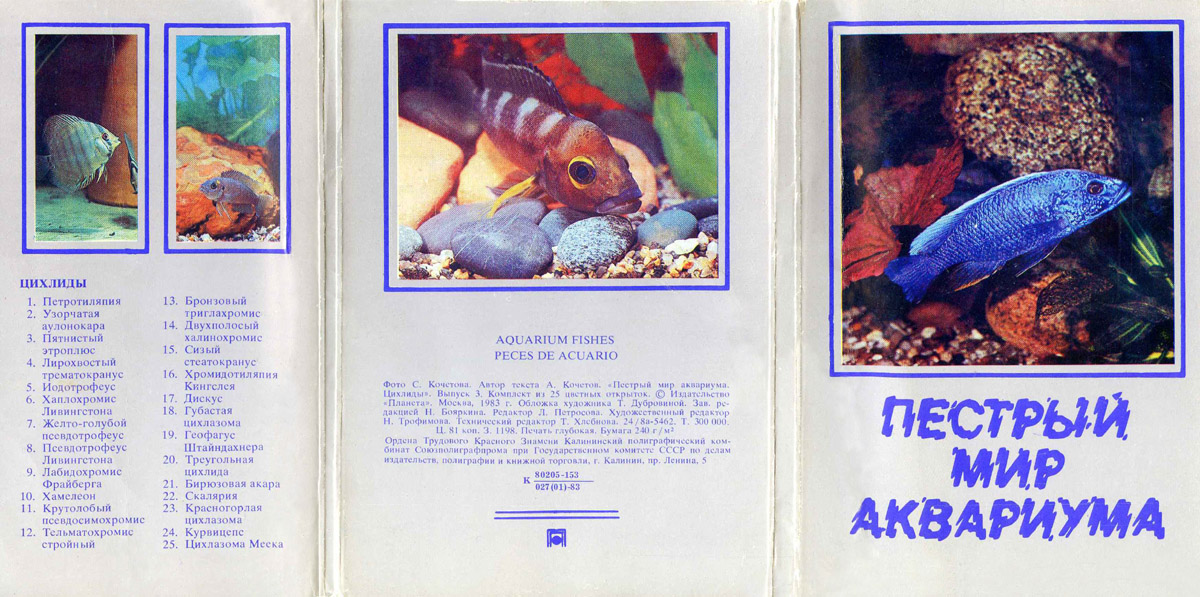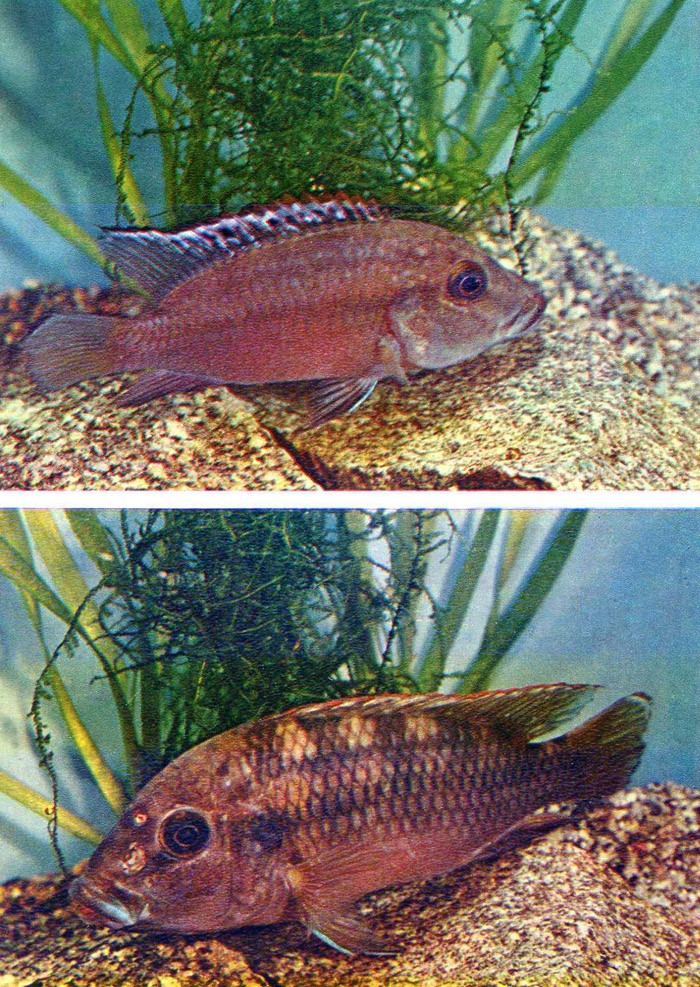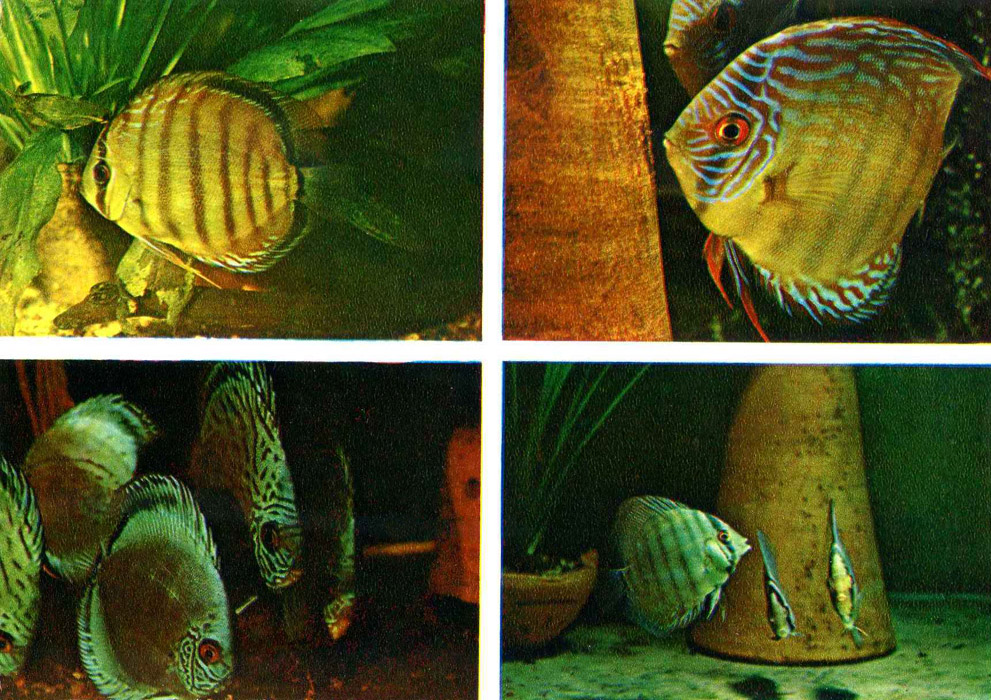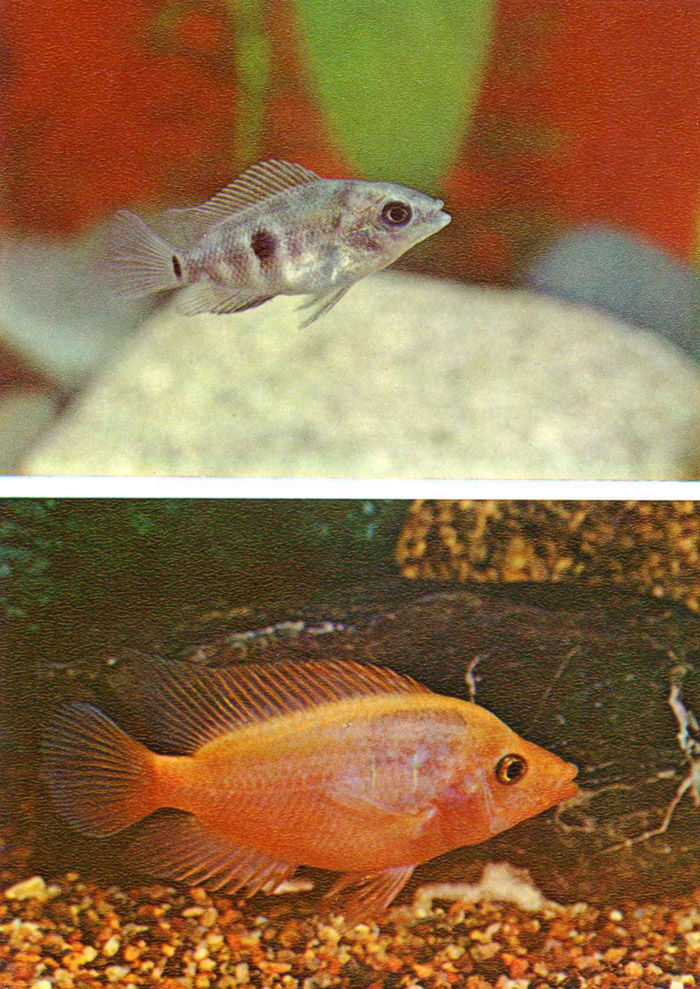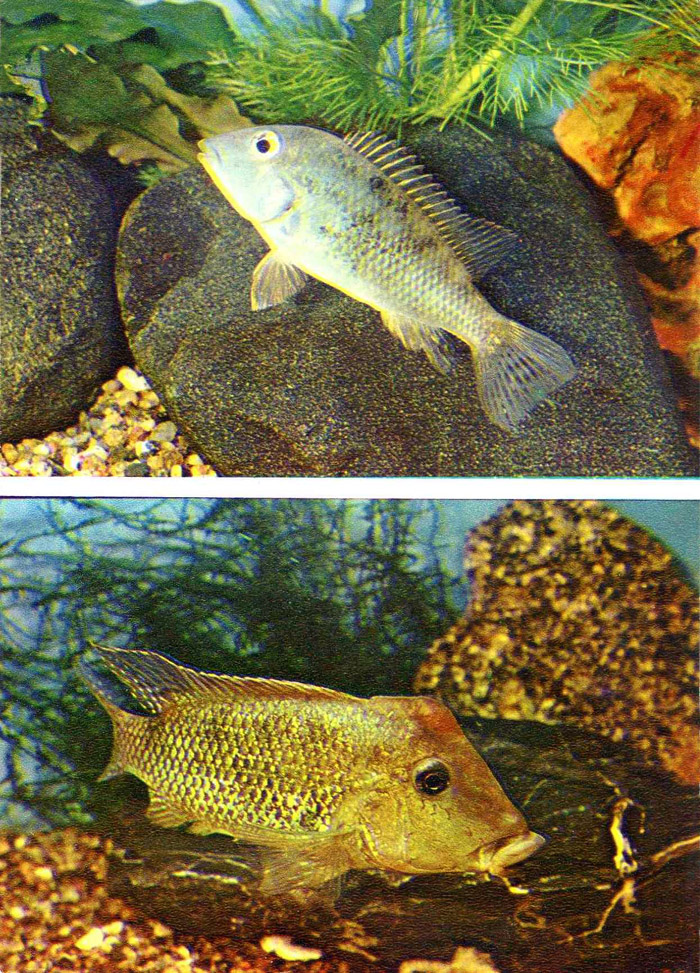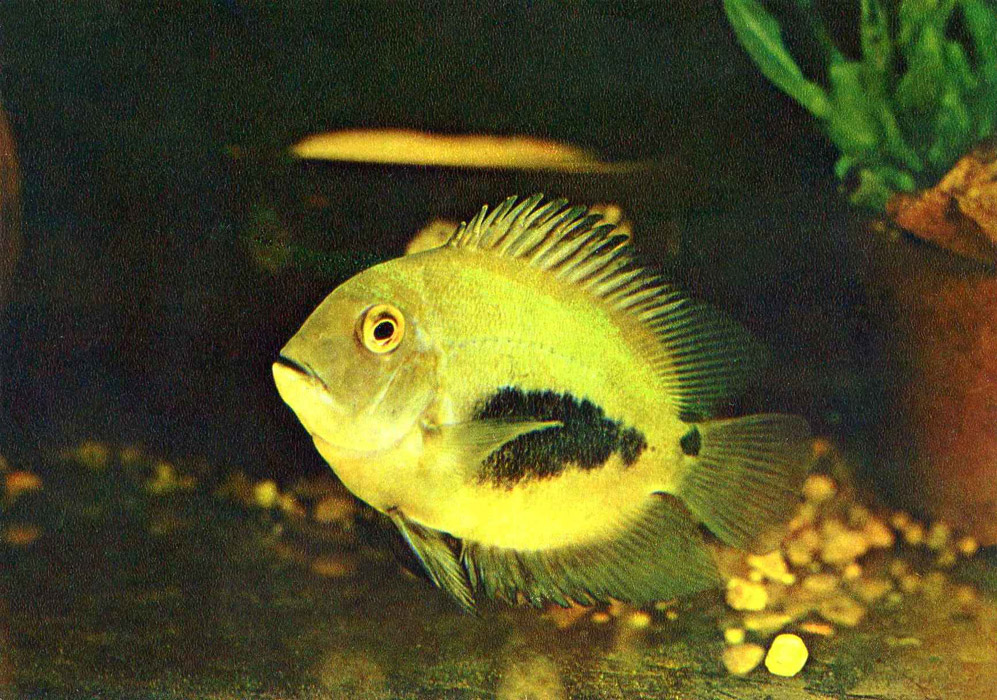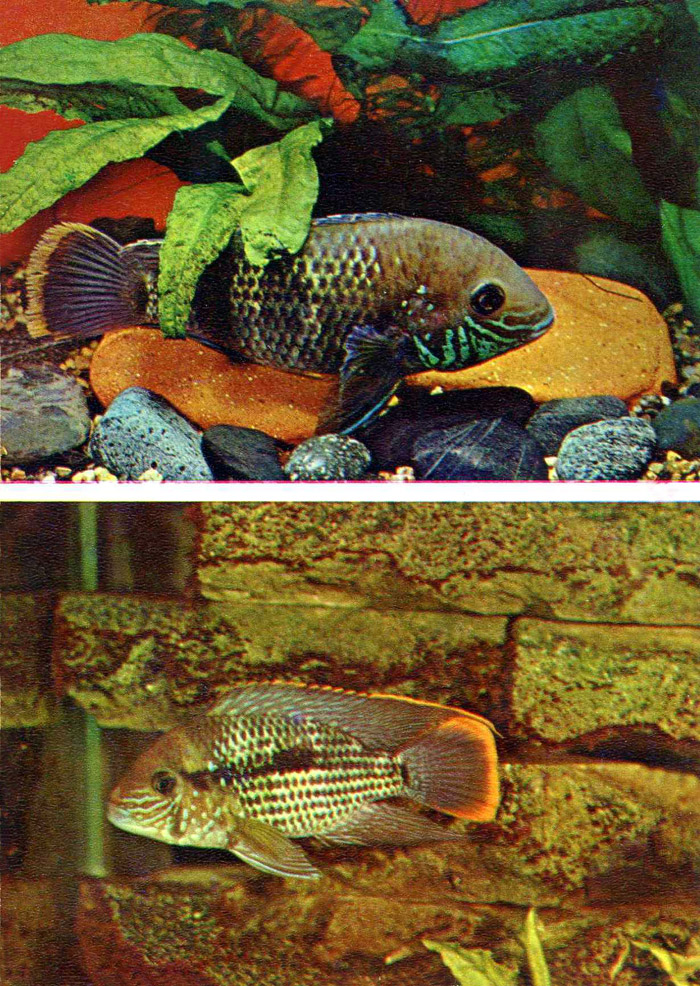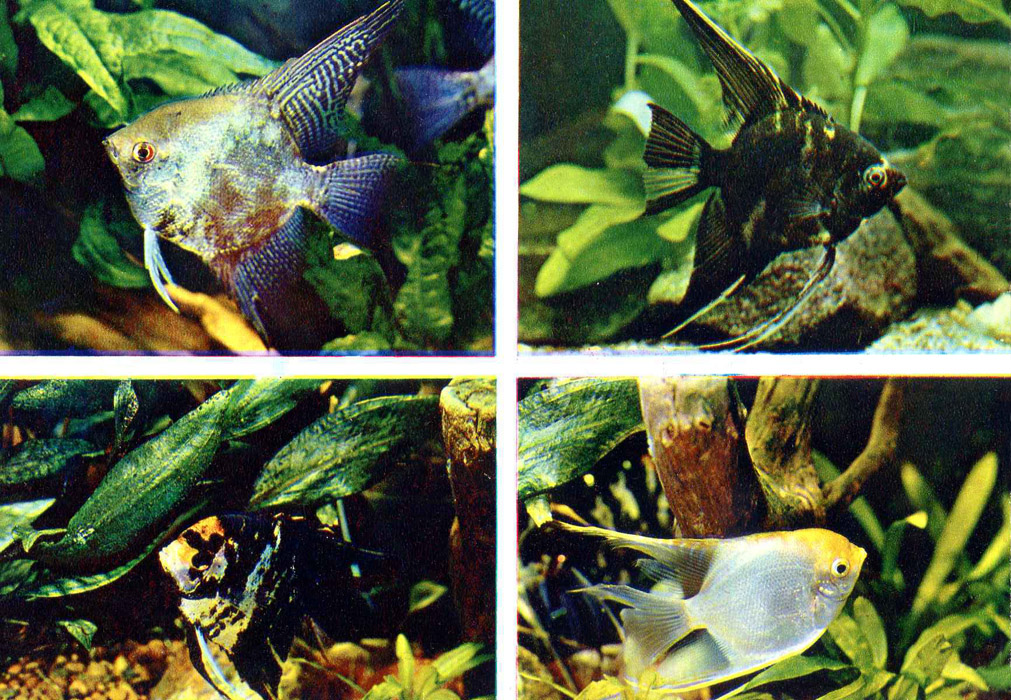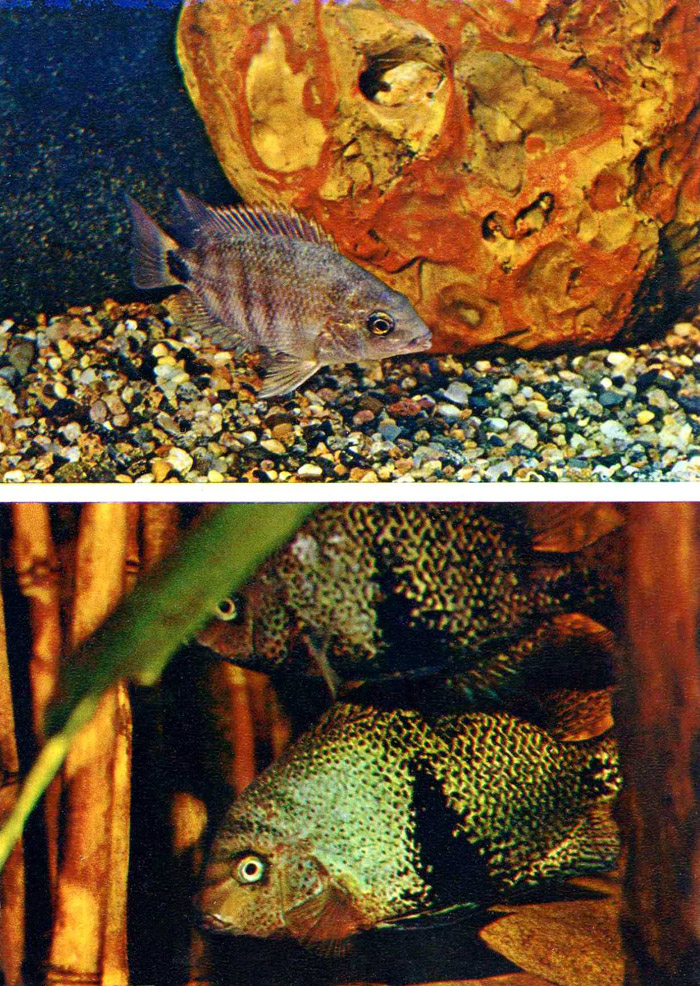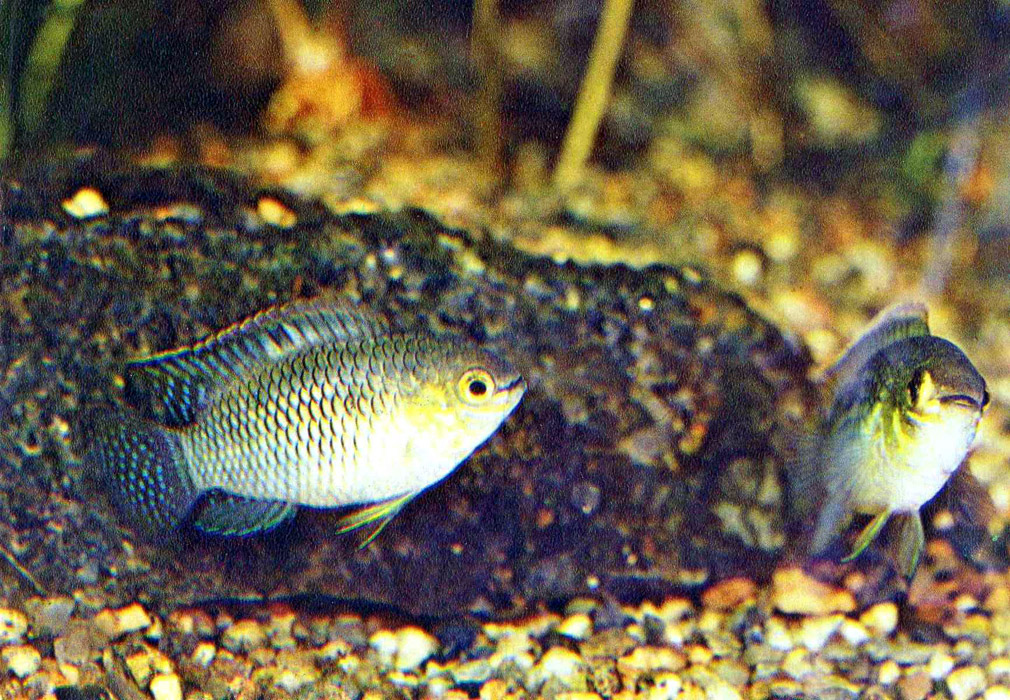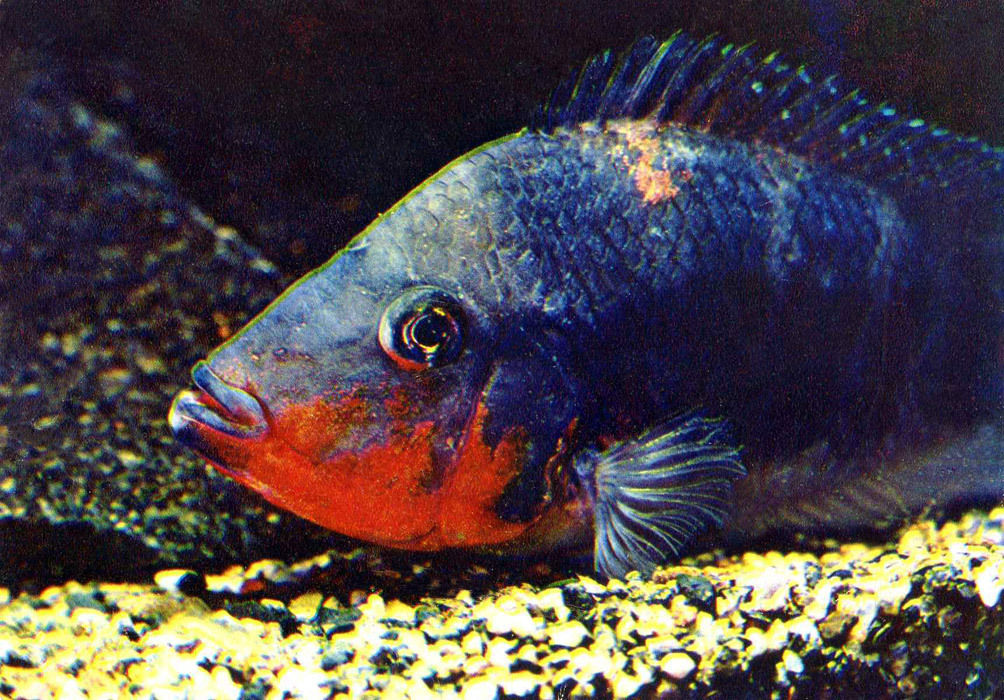В реках и озерах Южной, Центральной, Северной Америки и Азии обитает
243 вида цихлид, Африки — 547. Прародителями американских цихлид, вероятно,
были ископаемые акара и цихлазома, африканских — древние хаплохромис и
тиляпия. От других окунеобразных эти рыбы отличаются одной парой «носовых»
отверстий. Многие цихлиды имеют специфические приспособления: например
— раздувшаяся красная кожная складка на горле у Cichlasoma meeki служит
для устрашения противника, а пятна на анальном плавнике Pseudotropheus
и близких им видов играют сигнальную роль при нересте, привлекая самок.
Крупные тиляпии, цихлы и т. д. сегодня не только аквариумные рыбы, но и
популярные объекты спортивного лова, подводной охоты и промышленного рыборазведения.
У советских аквариумистов пока прижились 45 видов американских и азиатских
цихлид и 96 африканских. В группе легче ужинаются рыбы, близкие но размеру,
повадкам, месту обитания и темпераменту. Плотность посадки рассчитывают
из соотношения: 1 см длины рыбы на 2—3 литра воды. Высокотелые цихлиды
(скалярии, дискусы и др.) декоративнее выглядят в высоких аквариумах: ширина
в 1,5—2 раза меньше высоты. Размеры «эталонного» аквариума для совместного
содержания разных видов цихлид: длина 1—2,5 м, ширина и высота 0,5—1 м.
Укрытиями для рыб служат каменные террасы», коряжник (ольха, ива и т. д.),
поделки из пищевых пластиков и керамики. Животноядные цихлиды питаются
мелкими беспозвоночными, дождевыми червями и др. Растительноядные — мягкой
водной растительностью, ошпаренными и измельченными листьями салата, крапивы
и т. п. При размножении цихлидам (кроме видов, инкубирующих икру во рту)
необходим отдельный аквариум. Для сохранения икры, оставленной производителями,
следует применять инкубатор с замкнутой системой регенерации воды. Дезинфицируют
ее метиленовой синью (1 мг на 1 л).
Дисбаланс условий и паразитические микроорганизмы вызывают заболевания
у рыб. Для лечения применяют антибиотики (мономицин, бициллин-5,) фажизин
и др., трипофлавин; солевые, аммиачные и хлорофосные ванны и т. п. |
There are 243 species of Cichlids inhabiting the rivers and lakes of
South, Central and North America, Asia, and 547 in Africa. The fossil Aequidens and Cichlasoma were probably the primogenitors of the American Cichlids,
while the African ones are descended from the ancient Haplochromis and
Tilapia. Cichlids differ from other Perciformes in having a single pair
of nostrils. Many cichlids have specific adaptations, e. g. the swollen
red fold of skin on the throat of Cichlasoma meeki is used to frighten
off an adversary, while the ocelli or “egg-spots” on the anal fin of Pseudotropheus,
etc, are a signal to attract the female when spawning. Large Tilapias,
Cichlas, and others are now not only aquarium fishes, but also popular
for angling, underwater fishing and industrial fish-farming. Forty-five
American and Asian and also ninety-six African species of Cichlids have
so far become acclimatized with Soviet aquarists. Fishes similar by size,
habits, origin and temperament get on better in a common tank. The population
density in the aquarium should work out at 1 cm of body length per 2—3
litres of water. Cichlids with a disc-shaped body (angel fishes, discus
and others) look more decorative in high tanks: the width should be 1.5
to 2 times less than the height of the aquarium. The proportions of the
model community tank are as follows: length, 1 to 2.5 m, width and height,
0.5 to 1 m. Stone terraces, driftwood (alder, willow, etc), ceramic objects
or plastic food containers may be used as shelters for these fishes. Zoophagous
Cichlids feed on small invertebrates, earthworms, etc. Vegetarians feed
on soft aquatic vegetation or scalded and crushed lettuce and nettle leaves.
A separate aquarium is necessary for breeding cichlids (except mouth-breeders).
An incubator with a closed system of water regeneration is recommended
for the preservation of eggs abandoned by parents. Water in the incubator
is disinfected by methylene blue (1 mg per 1 litre).
Unbalanced conditions and parasitic microorganisms provoke fish diseases.
Antibiotics (monomycin, bicillin-5,) metronidazole, etc., tripaflavin,
saline, ammoniac and chlorophos baths are used as remedies. |
En los rios y lagos de Sudamerica, Americas Central y del Norte, Asia
habitan 243, especies de los ciclidos y en Africa, 547. Es posible que
los ciclidos del Nuevo Mundo asciendan a los Aequidens y Cichlasoma fosiles,
mientras que sus congeneres africanos, a los Haplochromis y Tilapia prehistoricos.
Se destinguen de los demas Perciformes por tener un solo par de fosas nasales.
Muchos de los ciclidos ostentan diferentes formas de adaptacion especifica.
Por ejemplo, los peces de la especie Cichlasoma meeki tienen un pliegue
dermico rojo en la zona de la garganta para aterrar al adversario, y las
mancha en la aleta anal de los machos Pseudotropheus, etc. sirven de atractivo
para las hembras a la epoca de la muga. Actualmente, telapias, cichlas
y otras especies mayores de tamano, ademas de ser objeto de la acuariofilia,
son objeto de pesca deportiva y subacuatica, como asimismo, de la piscicultura
industrial. Hasta el momento actual, los acuariofilos sovieticos han logrado
adaptar a 45 especies de los ciclidos americanos y asiaticos y a 96, de
los africanos. Entre varios, se adaptan mejor peces de un mismo tamano,
de rasgos etologicos y temperamentos parecidos y de un mismo habitat. La
densidad de populacion del acuario se calcula partiendo de 2 a 3 litros
de agua por I centimetro del largo del pez. Los ciclidos de cuerpo desarrollado
en sentido transversal Pterophyllum (Scalare, Symphysodon, etc) lucen mejor
en acuarios de contornos verticales : el ancho 1,5—2 veces menor que la
altura. Las dimensiones de un acuario “modelo” para tener juntos peces
de varias especies de los ciclidos, han de ser de 1—2,5 metros de largo
y de 0,5—1 metro de ancho y alto. Como refugios para los peces sirven terracitas
de piedras, ramitas torcidas de arboles (aliso, sauce, etc), grutas hechas
de plasticos admitidos en la industria alimentaria, o de ceramica. Las
especies carnivoras de los ciclidos se alimentan de pequenos invertebrados,
lombrices de tierra, etc. Y los ciclidos fitotrofos, consumen plantas acuaticas
blandas, hojas escaldadas y picadas de lechuga, ortiga y por el estilo.
Para la epoca de procreacion, los ciclidos —sin contar con las especies
que incuban los huevos en la boca— necesitan de un acuario aparte. Para
poder proteger los huevos puestos por los progenitores, se precisa una
incubadora con el ciclo cerrado de regeneracion del agua. Se desinfecta
con el azul de metileno (1 mg por litro de agua). Todo desequilibrio en
las condiciones de vida y los microorganismos parasitarios provocan enfermedades
de los peces. En tales casos, se aplican antibioticos (Monomycinum, Bicillini-5)
Tinidazol, etc., Tripaflavinum, banos con sales, amoniacales, etc. |
